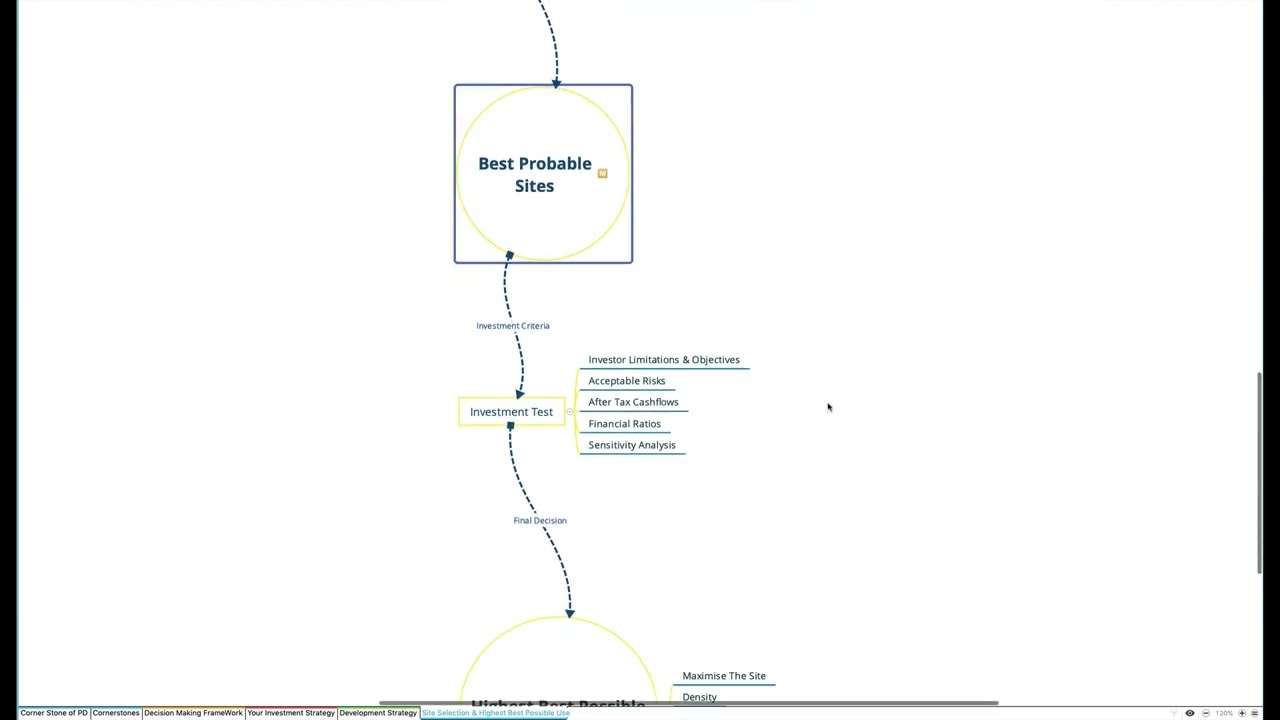Best Use Framework
Best Use Framework [PDF]
FAQ: Understanding Site Selection and Development Strategy in Real Estate
What is the purpose of evaluating physical characteristics in site selection?
The evaluation of physical characteristics such as the site’s size, shape, and environmental factors is crucial in determining the potential of a site for development. This analysis helps in understanding what type of development can be feasibly constructed, considering the land’s physical constraints and opportunities. Factors like the site’s topography, orientation, views, and building envelope significantly impact design and development options, ensuring the proposed project maximizes appeal and functionality.
How does market analysis influence real estate development decisions?
Market analysis is a critical step that involves examining general market trends, niche markets, consumer expectations, and future market potentials. This analysis helps developers understand the demand for different types of properties and align their projects with what potential buyers or tenants are looking for. By evaluating demographic profiles, sales, and rental data, developers can tailor their projects to meet specific market needs, increasing the project’s marketability and financial viability.
Why are infrastructure tests and legal constraints important in site selection?
Assessing the availability of services (like water and sewer connectivity), planned infrastructure developments, and understanding legal and environmental constraints are vital to ensure the feasibility of a development project. These aspects affect not just the cost and execution of the project but also its legal compliance and environmental sustainability. Zoning laws, in particular, dictate the permissible uses of the site, directly influencing its optimal development use.
What role do feasibility studies play in real estate development?
Conducting feasibility studies, including preliminary financial assessments and detailed feasibility analyses, is essential for understanding the economic viability of a project. These studies help in evaluating the potential returns on investment, assessing financial risks, and ensuring the project aligns with the developer’s financial objectives. They provide a foundation for making informed decisions based on qualitative and quantitative criteria.
How does a decision-making framework assist in real estate development?
A structured decision-making framework aids developers in screening potential sites by comparing them against a set of qualitative and quantitative criteria. This approach ensures that the selection aligns not only with market demands and physical feasibility but also with the developer’s personal preferences, skills, experience, and financial capacity. It enables a systematic evaluation process, leading to informed and strategic development decisions.
What is the significance of having a clear investment strategy in real estate development?
A clear investment strategy is essential for understanding the financial implications of a development project. It involves setting clear objectives regarding return on equity, managing debt exposure, and assessing the overall financial viability of the project. A well-defined investment strategy guides the financial planning of the development, ensuring that it is aligned with the developer’s financial goals and risk tolerance.
How does understanding the highest and best use of a property contribute to its development success?
Understanding the highest and best use of a property involves evaluating its physical characteristics, market demand, legal constraints, and financial feasibility to determine the most profitable and functional use of the site. This comprehensive approach ensures that the development not only complies with regulatory requirements but also meets market demands and aligns with the developer’s investment objectives, maximizing the project’s profitability and success.
Learn More 
Summary
Framework for Real Estate Site Selection and Use
The video provides a comprehensive guide to selecting and determining the most appropriate and profitable use of a site for real estate development. It breaks down the process into detailed analyses of physical characteristics, market potential, and infrastructure feasibility, among other factors. Here are the key findings and explanations, simplified for clarity:
Understanding Site Physical Characteristics
- Size and Shape Analysis: Assessing the dimensions and form of the site to identify what can be built. For example, a narrow plot might be suitable for a row of townhouses, while a larger area could accommodate a shopping center.
- Environmental and Zoning Constraints: Examining the land’s environmental conditions and legal zoning restrictions to understand what developments are permitted. It’s like checking the rulebook before playing a game to know what moves you can make.
- Design and Development Impact: The physical aspects such as orientation and views influence how a development is planned. It’s akin to arranging furniture in a room to make the most of natural light and views.
- Legal and Service Evaluations: Investigating legal issues and the availability of essential services like water and sewer systems, which are crucial for the feasibility and cost-efficiency of a project.
Conducting Market Analysis
- Trend and Micro-Market Analysis: Identifying both broad and niche market trends to locate opportunities. Imagine fishing where you know the fish are plenty and the type they are, to increase your chances of a good catch.
- Consumer Expectations: Understanding what potential buyers or tenants desire in properties, similar to knowing what guests prefer when planning a menu for a dinner party.
- Demographic Insights: Tailoring developments to the preferences of specific demographic groups, akin to customizing a product for its target audience to boost its appeal.
- Sales and Rental Data Review: Looking at sales and rental trends to decide on the type and scale of development, similar to a business analyzing sales data before launching a new product.
Infrastructure and Legal Constraints
- Evaluating the availability of essential infrastructure and potential environmental issues, as well as legal zoning laws, is crucial. It’s like ensuring a new car can be driven on all roads and meets all emissions standards before buying it.
Feasibility Studies and Investment Strategy
- Conducting financial assessments to understand the economic viability of a project and formulating a clear investment strategy to ensure profitability. This process is akin to planning a budget for a big purchase, ensuring it’s a smart investment that meets personal financial goals.
Development Strategy
- Emphasizing the importance of a coherent strategy that incorporates market research, investment plans, and a clear understanding of the site’s potential. This is similar to planning a journey, considering the destination, the route, and the mode of transport to ensure it meets your goals and preferences.
Key Takeaways
- Detailed Site and Market Analysis: A thorough understanding of the site’s physical characteristics and market demands is crucial for successful development.
- Strategic Planning and Feasibility: Evaluating the feasibility and aligning it with a well-defined investment and development strategy ensures projects are both viable and aligned with market demands.
- Adaptation and Flexibility: The ability to adapt strategies based on detailed analyses and changing market conditions is key to maximizing profitability and success in real estate development.
In essence, the video outlines a methodical approach to real estate development, focusing on meticulous planning, market understanding, and strategic decision-making. It emphasizes the importance of aligning every aspect of the development process with both market demands and the developer’s objectives to ensure the success and profitability of projects.
Test Your Knowledge
1. What is the purpose of evaluating physical characteristics in site selection for real estate development?
A. To determine the property’s eligibility for tax exemptions
B. To assess the site’s suitability for development based on size, shape, and environmental factors
C. To estimate the site’s resale value without development
D. To comply with local community requests
2. How does market analysis influence real estate development decisions?
A. It is solely for determining the color schemes of future developments
B. Market analysis helps align projects with consumer expectations and market demands
C. It dictates the architectural styles to be used in development
D. Market analysis is a formality and does not significantly impact decisions
3. Why are infrastructure tests and understanding legal constraints crucial in site selection?
A. They ensure the development project will receive media attention
B. Infrastructure and legal constraints determine the feasibility and compliance of the development
C. They are only necessary for developments in urban areas
D. Legal constraints are considered outdated and rarely impact site selection
4. What role do feasibility studies play in real estate development?
A. They provide a formal documentation for public relations purposes
B. Feasibility studies assess the economic viability and potential returns on investment
C. They are conducted to satisfy investor curiosity
D. Their primary role is to determine the construction timeline
5. How does a structured decision-making framework assist in real estate development?
A. By ensuring the development aligns with personal preferences and market demands
B. It is mainly used for resolving disputes among developers
C. The framework is a legal requirement for obtaining funding
D. It prioritizes aesthetic considerations over financial viability
6. Why is having a clear investment strategy essential in real estate development?
A. To guarantee approval from local authorities
B. It outlines objectives regarding return on equity and financial viability
C. A clear strategy ensures the development will be completed ahead of schedule
D. It is primarily for marketing purposes to attract buyers
7. How does understanding the highest and best use of a property contribute to development success?
A. By ensuring the project meets only the minimum regulatory requirements
B. Understanding the highest and best use maximizes profitability and aligns with market demands
C. It focuses on achieving the lowest possible development cost
D. It guarantees that the development will have no environmental impact
Answers:
- B. To assess the site’s suitability for development based on size, shape, and environmental factors
- B. Market analysis helps align projects with consumer expectations and market demands
- B. Infrastructure and legal constraints determine the feasibility and compliance of the development
- B. Feasibility studies assess the economic viability and potential returns on investment
- A. By ensuring the development aligns with personal preferences and market demands
- B. It outlines objectives regarding return on equity and financial viability
- B. Understanding the highest and best use maximizes profitability and aligns with market demands
Assignment
Objective:
This exercise aims to apply the concepts of site selection and development strategy in real estate. Students will demonstrate their understanding of evaluating physical characteristics, conducting market analysis, assessing infrastructure and legal constraints, performing feasibility studies, and applying decision-making frameworks to select a site and propose a development strategy.
Assignment Overview
Students will work in groups to select a hypothetical site for development. They will then analyze the site’s potential based on the framework provided in the “FAQ: Understanding Site Selection and Development Strategy in Real Estate” article and propose a development plan that aligns with market demands and investment goals.
Tasks
- Site Selection
- Choose a hypothetical site for development. Describe its size, shape, and location.
- Research and list the environmental and zoning constraints that might affect development on this site.
- Physical Characteristics Evaluation
- Assess the site’s physical characteristics (e.g., topography, orientation, views) and explain how these might influence the design and development options.
- Market Analysis
- Conduct a mock market analysis that includes:
- Identifying general market trends and niche markets relevant to your site.
- Analyzing potential consumer expectations for properties developed on this site.
- Reviewing demographic profiles that match the target market for your development.
- Gathering sales and rental data to estimate the demand and pricing strategy for your development.
- Infrastructure and Legal Constraints
- Evaluate the availability of essential services and planned infrastructure improvements.
- Discuss any legal and environmental constraints affecting development, including zoning laws.
- Feasibility Studies
- Perform a simplified financial assessment to determine the economic viability of the proposed development. Include assumptions about costs, potential sales/rental income, and desired return on investment.
- Decision-Making Framework and Investment Strategy
- Apply a decision-making framework to justify the selection of your site and the type of development proposed.
- Outline a clear investment strategy for the development, considering financial goals and risk tolerance.
- Development Proposal
- Based on the analyses conducted, propose a specific type of development (e.g., residential, commercial, mixed-use). Describe the proposed development, including its scale, design concept, and how it aligns with market demands and site characteristics.
Research Questions
- What are the current market trends in the real estate sector, and how do they impact development decisions?
- How do zoning laws vary in different regions, and what impact do they have on development potential?
- What are common environmental issues that can affect real estate development, and how can they be mitigated?
To Do:
- Collaborate and Research: Work together to research the necessary information for each task.
- Analysis and Proposal Development: Utilize the provided framework to analyze the chosen site and develop a comprehensive development proposal.
Presentation: Prepare a presentation summarizing your findings, analyses, and proposed development plan. Include visual aids and data to support your proposal.



